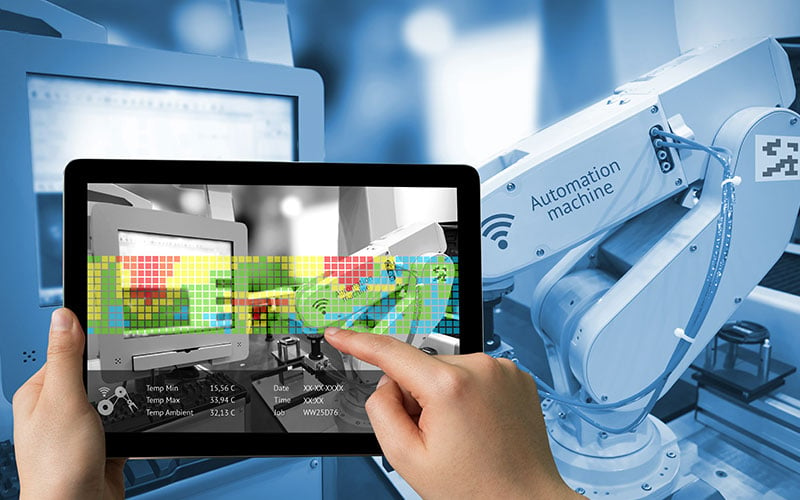Smarter asset maintenance: digital technology and its impact on downtime
SAGE Automation, Published: March 7, 2019 - Updated: February 25, 2020 (11 min read)
While some are still reading about the value of industry 4.0, other industrial operators are already taking advantage of new technologies that are reducing their risk of extended downtime through fast response, support and prevention.
Industry 4.0 signifies the rise of digital technologies, data, computing power, connectivity, machine-human interactions, and their ability to disrupt and improve the way we do business.
While industry 4.0 trends such as these have been building momentum for some time, McKinsey says that, “many are now at a point where their greater reliability and lower cost are starting to make sense for industrial applications”.
This is especially true for those wanting to better manage their assets, respond faster to faults and improve their maintenance programs.
While we don’t recommend forgetting the golden rules of backups, spares and documentation and their importance in your ability to respond to control system breakdowns, there are a few especially powerful and digital technologies and strategies that will improve your response time and uptime.
We outline them in detail below.
1. Internet of Things enabled monitoring

Technologies: RTU-Datalogggers, 3G/4G/5G networks, Sigfox, LoRaWAN, cloud-based platforms.
Explain it: Industrial asset or site monitoring can involve connecting field devices to cloud-based SCADA via IoT networks to provide monitoring and alarming of previously unmonitored sites. Sensors are becoming smarter too, for example IO link has inbuilt diagnostics to enable you to see failures from the desk rather than travelling out to the field.
Effect: IoT solutions are comparatively low cost and quick to implement in remote sites, obscure or hard-to-access sites or the plant floor. Often these solutions are controlled via a cloud-based SCADA, which can offer increased data security through safe, offsite hosting with full redundancies in place. It also offers monitoring capability to smaller operations without a traditional SCADA.
This remote monitoring capability has a direct impact on asset maintenance costs and the ability to respond to faulting assets through alarming.
Example:
Melbourne Water wanted to monitor a number of sites that are typically below ground and/or low lying assets to assist in providing a higher level of service to its customers. These sites had previously been unmonitored due to challenges in access, location and power. More than 70 assets were remotely monitored through a cloud-based SCADA interface ‘STRATUS’ and specially configured monitoring hardware. This achieved increased visibility of its sites for improved lifetime maintenance costs, customer experience, environmental management and reduced capital expenditure.
“Remote monitoring through the IoT is really about doing more with less,” SAGE Automation Control Systems Support Project Lead Andrew O’Regan says.
“We can use smart devices, the internet and cloud platforms to collect and store data from assets without needing a site visit, AND provide alarming for when something goes wrong. So it arms you with both tangible data and responsiveness.”
Read more: 6 cross-industry applications of industrial IoT in practice
2. Big data, IT-OT integration, time-series databases, machine learning

Advancements in connectivity means industrial plants will soon be faced with an overwhelming amount of data – and it will go to waste if the system can’t store, process and turn it into valuable insights. This is why a powerful database is essential for any business going forward.
“The key value of software and plant level connectivity and the resulting data, is in how it is analysed, and acted upon,” Mr O’Regan says.
Technology: Integration and advanced analysis of data using sensors, systems and database technology such as Manufacturing Execution Systems (MES) and Manufacturing Information Systems (MIS), data historians, time-series databases + more….
Explain it: Many businesses still use paper to log their data. This could be via trends in a SCADA system or simply using Excel to track data over time. Historians and time-series databases have far greater capability to do complex analysis of data sets over time. For example, picking up patterns that lead to failure events. Operations managers may be able to find this information from spreadsheets, but only after a failure event. Historians can pick up patterns, anomalies and even be taught to look for these signals to alert managers of events before they happen.
Effect: This type of pattern analysis is providing the foundations for machine learning. For now though, it can help reduce error, prevent faults and increase overall quality in manufacturing.
Example: TasWater has leveraged its live and historical data to detect sewer blockages in their infancy, thereby preventing potential spill events. Its sewer blockage detection system is able to detect a partial blockage event 13 hours ahead of current methods based on available historical data.
Read the case study: Predictive analytics set to prevent spills, save environment
3. Portable VPN for remote support

Technology/application: SAGE’s Remote Support Module (RSM)
Explain it: The RSM is a portable VPN that provides remote access to a facility’s control systems – with no configuration required to the existing network. It is basically a black box that you can carry to your piece of faulting equipment, plug in and allow a SAGE Service Technician to remotely access and resolve. The box itself is locked and secured with cypher and TLS authentication for maximum security.
Effect: The technology allows third party experts to access to your systems only when you want them to, which means they can remotely diagnose and fix control system faults.
"This results in savings on configuration, call out fee and travel time,” Mr O’Regan says. “This is different to anything else on the market because it doesn’t need configuration on customer network, it has military grade encryption and it is mobile – which means it allows faster breakdown recovery.”
Example: Qualia Wines is more than four hours’ drive from Adelaide and five and-a-half hours from Melbourne. A power outage at their site had resulted in plant wide shut down. A technician at SAGE’s National Operations Centre was able to remotely access their SCADA system and site network to recover the PLC and rectify the communication errors, saving the winery five hours of travel time and associated costs of downtime.
4. Wearables

Technology/ application: Mobile devices paired with automated workflows, apps and integrated software is bringing on the ‘connected worker’ phenomenon. One small part of this is HTML 5 enabled SCADA systems, which brings SCADA to the mobile device.
Explain it: Smartphones and wearable technology made for the average consumer are now being integrated into industrial contexts to make things more efficient.
Example: A few Australian food and beverage clients are integrating the connected worker approach to their production and quality processes. Connected workers start work orders, complete quality checks and log raw materials — all from a smart mobile device.
Effect: Push notifications (such as alerts for machine stoppage events or critical control points heading out of specification) enable the connected worker to rectify issues in a timelier manner. Remote SCADA allows operators to diagnose and fix issues at the asset rather than having to walk back and forth between the asset and control room.
Without the need to monitor machines, staff can focus on continuous improvement. It generates a proactivity vs. reactivate approach.
“Proactivity results in a preventative rather than a reactive ‘fire-fighting’ maintenance strategy,” Mr O’Regan says.
Read more: International manufacturer leads the way in 4.0 digitisation
5. Virtualisation

Technology: Virtual machines, virtual server, virtual hard disk
Explain it: Anything from your HMI and SCADA servers, to engineering and business systems and their background files can be mirrored on virtual hard drives. This functionality has much cross over with the ‘digital twin’ concept, where the mirrored system can run in the virtual world and perform exactly as its real life counterpart. As such, the virtual machine can act as a backup, or as a much more powerful simulation tool.
Effect: As a backup, the virtual machine allows you to more quickly reconfigure and install your system as a result of hard drive loss vs traditional backups. This results in reduced downtime, and added security knowing you have your entire systems are backed up.
Example:
“This technology is great for people running OEM or legacy software packages that only run on an earlier version of Windows. When their hardware fails the software is incompatible with newer versions of Windows OS,” Mr O’Regan says.
“They’re left with two solutions:
1) re-engineer from scratch which can take months, and tens-of-thousands-of-dollars or 2) virtualise the system and mount it in new supported hardware for a fraction of the cost and reduced downtime.”
6. New support models

Technology: All of the above.
Explain it: Advances in digital technologies are providing industrial companies with the opportunity to improve their maintenance and operations. But sometimes the business isn’t best placed to get insights from its own data.
In many cases, solution providers with the data, knowledge and/or install base can derive insights better than the end user.
“So much so that we’re seeing a transition in the vendor/solution provider service model,” says SAGE Automation Principal Engineer Steven Bailey in an article on how to leverage big data while filling the skills gap.
“Industrial clients are broadening their support from scheduled maintenance services and responsive breakdown call-outs to include real-time operational monitoring and analytics services,” he explains.
Effect: Leveraging a 3rd party expert can drive value out of your data, increase your downtime response at a lower overhead, and learn from them in the process.
Example: SAGE provides continuous monitoring and remote breakdown support through its National Operations Centre. Clients include Adelaide Airport, the South Australian Department of Planning Transport and Infrastructure and Container Deposit Systems, and more companies across manufacturing, utilities and transport.
“These clients expect to benefit from having senior control systems technicians monitoring their assets, and responding to alarms and faults instantly to keep them online,” Mr O’Regan says, “We’re also moving towards leveraging historical and real-time data to build better maintenance plans.”
In summary
If there’s one thing we can be certain of it is that machines and equipment will fault, and industrial operators need to be prepared as possible.
While traditional downtime reduction methods like PLC backups, spares, updated documentation and staff training are vital preparations, approaches such as database management and advanced data analysis, IoT monitoring, remote support, a connected workforce, and leveraging 3rd party experts are proving to be just as, if not more impacting on the ability to respond sooner to breakdown.
As these digital technologies and methods come on the market, industrial operators will do well to adopt some of these strategies in order to reduce their risk around extended downtime when failure happens.
Are you a SAGE client and want to kick-start your breakdown recovery plan? Explore the SAGE Go app here:









